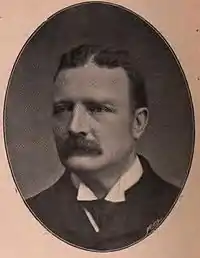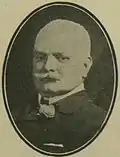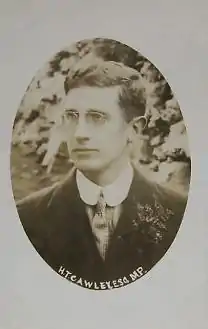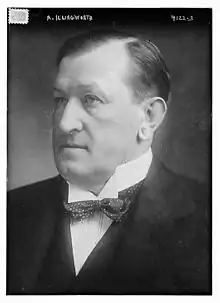Heywood (UK Parliament constituency)
Heywood was a county constituency in the county of Lancashire of the House of Commons for the Parliament of the United Kingdom which existed between 1885 and 1918.[1] Created by the Redistribution of Seats Act 1885, it was represented by one Member of Parliament. The constituency was abolished in 1918.[2]
| Heywood | |
|---|---|
| Former County constituency for the House of Commons | |
| 1885–1918 | |
| Seats | one |
| Created from | South East Lancashire |
| Replaced by | Heywood and Radcliffe |
The 2023 Periodic Review of Westminster constituencies proposes to re-establish the seat in its revised proposal.[3]
Boundaries and History
This area had previously been represented as part of the South East Lancashire multi-seat division. The Redistribution of Seats Act 1885 divided the former constituency into eight new single-member seats, one of which was designated South-East Lancashire, Heywood Division.[4]
The constituency comprised the Municipal Borough of Heywood, the cotton town of Ramsbottom, and a number of surrounding townships, namely: Ainsworth, Ashworth, Pilkington, Tottington Higher End and the rural part of the parish of Spotland.[5]
The constituency was mostly industrial but it included some agriculture. The town of Heywood was the most Liberal part of the constituency, having an engineering-based economy; Ramsbottom was more marginal politically. The countryside element of the constituency was Conservative inclined. Overall the division was Liberal 1885–1895, Liberal Unionist 1895–1904 and after a change of allegiance by the sitting MP was Liberal again from 1904 until the constituency was abolished in 1918.
The constituency adjoined Westhoughton to the west, Rossendale to the north, Middleton and Rochdale to the east as well as Radcliffe-cum-Farnworth, Bury, and another part of the Middleton constituency to the south.
The Representation of the People Act 1918 abolished this constituency. The successor seat was Heywood and Radcliffe.
Members of Parliament
| Election | Member | Party | |
|---|---|---|---|
| 1885 | Isaac Hoyle | Liberal | |
| 1892 | Thomas Snape | Liberal | |
| 1895 | George Kemp | Liberal Unionist | |
| 1904 | Liberal | ||
| 1906 | Sir Edward Holden, Bt | Liberal | |
| Jan 1910 | Harold Thomas Cawley | Liberal | |
| 1915 by-election | Albert Illingworth | Liberal | |
| 1918 | constituency abolished: see Heywood and Radcliffe | ||
Elections
Elections in the 1880s

| Party | Candidate | Votes | % | ±% | |
|---|---|---|---|---|---|
| Liberal | Isaac Hoyle | 4,538 | 53.4 | ||
| Conservative | James Kenyon | 3,955 | 46.6 | ||
| Majority | 583 | 6.8 | |||
| Turnout | 8,493 | 91.6 | |||
| Registered electors | 9,269 | ||||
| Liberal win (new seat) | |||||

| Party | Candidate | Votes | % | ±% | |
|---|---|---|---|---|---|
| Liberal | Isaac Hoyle | 4,206 | 52.8 | -0.6 | |
| Conservative | John Lawson | 3,762 | 47.2 | +0.6 | |
| Majority | 444 | 5.6 | -1.2 | ||
| Turnout | 7,968 | 86.0 | -5.6 | ||
| Registered electors | 9,269 | ||||
| Liberal hold | Swing | -0.6 | |||
Elections in the 1890s
| Party | Candidate | Votes | % | ±% | |
|---|---|---|---|---|---|
| Liberal | Thomas Snape | 4,366 | 53.8 | +1.0 | |
| Liberal Unionist | Sir Henry Hayes Lawrence, 2nd Baronet | 3,745 | 46.2 | -1.0 | |
| Majority | 621 | 7.6 | +2.0 | ||
| Turnout | 8,111 | 87.7 | +1.7 | ||
| Registered electors | 9,251 | ||||
| Liberal hold | Swing | +1.0 | |||

| Party | Candidate | Votes | % | ±% | |
|---|---|---|---|---|---|
| Liberal Unionist | George Kemp | 4,489 | 53.3 | +7.1 | |
| Liberal | Thomas Snape | 3,933 | 46.7 | -7.1 | |
| Majority | 556 | 6.6 | N/A | ||
| Turnout | 8,422 | 90.2 | +2.5 | ||
| Registered electors | 9,334 | ||||
| Liberal Unionist gain from Liberal | Swing | +7.1 | |||
Elections in the 1900s
| Party | Candidate | Votes | % | ±% | |
|---|---|---|---|---|---|
| Liberal Unionist | George Kemp | 4,657 | 51.2 | −2.1 | |
| Liberal | Edward Holden | 4,431 | 48.8 | +2.1 | |
| Majority | 226 | 2.4 | −4.2 | ||
| Turnout | 9,088 | 90.7 | +0.5 | ||
| Registered electors | 10,022 | ||||
| Liberal Unionist hold | Swing | -2.1 | |||

| Party | Candidate | Votes | % | ±% | |
|---|---|---|---|---|---|
| Liberal | Edward Holden | 5,351 | 55.8 | +7.0 | |
| Liberal Unionist | Mervyn Manningham-Buller | 4,245 | 44.2 | −7.0 | |
| Majority | 1,106 | 11.6 | N/A | ||
| Turnout | 9,596 | 91.7 | +1.0 | ||
| Registered electors | 10,463 | ||||
| Liberal gain from Liberal Unionist | Swing | +7.0 | |||
Elections in the 1910s

| Party | Candidate | Votes | % | ±% | |
|---|---|---|---|---|---|
| Liberal | Harold Thomas Cawley | 5,809 | 55.0 | -0.8 | |
| Conservative | Mervyn Manningham-Buller | 4,750 | 45.0 | +0.8 | |
| Majority | 1,059 | 10.0 | -1.6 | ||
| Turnout | 10,559 | 93.1 | +1.4 | ||
| Liberal hold | Swing | -0.8 | |||
| Party | Candidate | Votes | % | ±% | |
|---|---|---|---|---|---|
| Liberal | Harold Thomas Cawley | 5,430 | 53.9 | -1.1 | |
| Conservative | Robert A L Hutchinson | 4,641 | 46.1 | +1.1 | |
| Majority | 789 | 7.8 | -2.2 | ||
| Turnout | 10,071 | 88.8 | -4.3 | ||
| Liberal hold | Swing | -1.1 | |||
General Election 1914–15:
Another General Election was required to take place before the end of 1915. The political parties had been making preparations for an election to take place and by the July 1914, the following candidates had been selected;
- Liberal: Harold Thomas Cawley
- Unionist: Thomas Fermor-Hesketh[7]

| Party | Candidate | Votes | % | ±% | |
|---|---|---|---|---|---|
| Liberal | Albert Holden Illingworth | Unopposed | |||
| Liberal hold | |||||
References
- "Parliamentary Constituencies and their registers since 1832" (PDF). British Library.
- Water-supply Paper. U.S. Government Printing Office. 1931.
- "North West | Boundary Commission for England". boundarycommissionforengland.independent.gov.uk. Retrieved 15 June 2023.
- Schedule 7: Counties at Large, Number of Members and Names and Contents of Divisions, Redistribution of Seats Act, 1885 (C.23)
- F A Youngs Jr., Guide to the Local Administrative Units of England, Vol.II: Northern England, London, 1991
- British Parliamentary Election Results 1885-1918, FWS Craig
- Manchester Courier and Lancashire General Advertiser 18 May 1914
Sources
- Leigh Rayment's Historical List of MPs – Constituencies beginning with "H" (part 3)
- Boundaries of Parliamentary Constituencies 1885–1972, compiled and edited by F.W.S. Craig (Parliamentary Reference Publications 1972)
- British Parliamentary Election Results 1885–1918, compiled and edited by F.W.S. Craig (Macmillan Press 1974)
- Social Geography of British Elections 1885–1910. by Henry Pelling (Macmillan 1967)
- Who's Who of British Members of Parliament, Volume II 1886–1918, edited by M. Stenton and S. Lees (Harvester Press 1978)
- Who's Who of British Members of Parliament, Volume III 1919–1945, edited by M. Stenton and S. Lees (Harvester Press 1979)